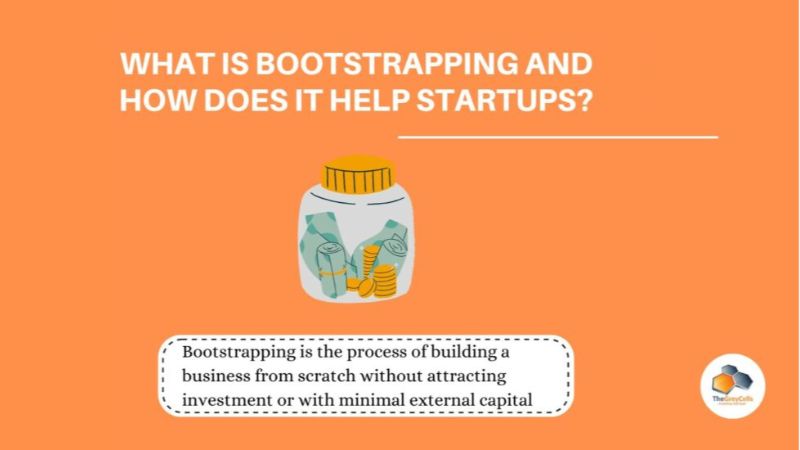“Entrepreneurship is about being able to face failure, manage risk, and keep pushing for what you believe in, even if that means bootstrapping your way to success.” — Naveen Jain
However, all these ways involve the risk factor that can be huge for first-time entrepreneurs. In case your business didn’t make the profit it needs, you may end up in heavy debt.
But what if there is another way to start your startup without raising funds?
Yes, you heard it right. One can go for bootstrapping where founders start a company with little capital relying on personal savings or operating revenue.
In this article, we will discuss bootstrapping and how you can do it for starting your startup.
What is Bootstrapping?
Bootstrapping is a startup or a company that has started and scaled without the use of any external funding. It might be non-funded or self-funded. It means companies have not raised any funding at all or may have raised it from their founding numbers.
Bootstrapping means the company has not sold its share to any external entity. Bootstrapped companies depend on the revenues that they generate or the profits they make from their business for scaling and marketing or day-to-day operations.
For instance, a bootstrapped company takes pre-orders and uses that amount to build and deliver the product.
You don’t have to depend on venture capitalists, crowdfunding, or angel investors instead you can believe in yourself and start your venture.

THE 7-STEP STARTUP SUCCESS FORMULA - DR. ANU KHANCHANDANI
Every entrepreneur’s journey is a mix of failures and successes. The probability of failure is higher, however, there is a way to grow and keep growing until you build a successful startup. This book is one such guide to help you with 7 formulas for your success.
How does it work?
Bootstrapping is more suited for those entrepreneurs who have great practical ideas but don’t have sufficient funds to start a business. It is also a better option for small-scale businesses. Here you can generate revenue through your job or another business or your life’s savings.
There are three stages of bootstrapping. Let’s explore them.
Stage 1 : Self-funding
Bootstrapping is more suited for those entrepreneurs who have great practical ideas but don’t have sufficient funds to start a business. It is also a better option for small-scale businesses. Here you can generate revenue through your job or another business or your life’s savings.
There are three stages of bootstrapping. Let’s explore them.
Stage 2: Revenue gained from customers
In this stage, you will accumulate a good amount of funds from your customers and you won’t need your savings. You will be able to pay the bills and run day-to-day operations with this income.
Startup founders focus on scaling their business and making it profitable by building a strong team of employees.
|
|
Thank you for Signing Up |


Stage 3: Credit
This is the stage where you have crossed your break-even point and have a regular income from your business. These revenues can be used to take out business loans to accumulate a large amount of capital.
This stage helps in scaling your business tremendously and creating a name in the market. Founders even start listing in share markets as an IPO (Initial Public Offering).
Examples of some successful bootstrapped startups
Bootstrapping is a crucial skill for founders as it teaches them to be independent and create a successful business model. Bootstrapping help them in staying for the longer term and get success of their company.
Here are some examples of startups that are massively successful by bootstrapping their business.
1. Shopify
It is a Canadian multinational e-commerce company headquartered in Ottawa, Ontario with a valuation of $48.43 billion.Tobias Lütke and Scott Lake develop their e-commerce website from scratch and raised funds through bootstrapping for 6 years. Later they went for an IPO after building a strong stand in the market.
2. Zerodha
Zerodha is an Indian financial services company founded by Nithin Kamath and Nikhil Kamath in the year 2010. In just 10 years, it went from 0 to $1 Billion in valuation with zero external funding and marketing.
3. Shutterstock
Jon Oringer launched Shutterstock in 2003 by charging $49 monthly for unlimited use of the 30000 photos he took. He was a software developer and amateur photographer who bootstrapped his business till he acquired a large amount of capital. This led to Shutterstock being worth over 2 billion dollars after it IPOed in 2012
Note: You can explore more about fundraising and how bootstrapping can be the first step in starting a startup in the book “THE 7- STEP STARTUP SUCCESS FORMULA – Anu Khanchandani.” You can read chapter 13 to understand the process of raising funds in easy ways. This resourceful book will provide insights related to the growth of your startup.
You can buy it here: THE 7- STEP STARTUP SUCCESS FORMULA
How to bootstrap your startup?
Bootstrapping helps startups in developing and launching their company into the market with the less financial risk involved and with total ownership. Startups get a kickstart and when the profit margin is high then they can leverage this in raising loans or debts. This helps them in scaling their business to a higher level.
A few methods that can be used in bootstrapping your business are mentioned below. Have a look!
1. Determine the amount you need and whether you are going solo or need a co-founder
You have to figure out the expenses that will occur in your startup and evaluate your savings. You also have to determine the period till your income is going to support it. Analyze whether and how much you need to pay in purchasing software, or equipment.Think about your journey as a self-owned founder or do you need a founder? A founder can be of great help in diving the risk while bringing in extra capital and expertise.
2. Build your company while staying in your job
Don’t make the mistake of quitting your job before your business starts generating revenue. This will allow you to have extra time to establish your company. It will require a lot of hustle but you will be financially dependent on its salary.
3. Create an MVP and build an audience before launching
In bootstrapping, it’s essential to focus on creating an MVP (Minimum Viable Product). An MVP is not only the product but the basic version of your value proposition that will help you validate your idea or product and start generating revenue. Start connecting with your audience through social media or any other form of marketing that requires fewer funds. You should introduce your company, its product, or its services before launching your company. So that once your company is launched, you have some orders beforehand.
4. Take paid pre-orders and develop a team
Always try to gather some pre-orders through marketing your product and once you get that build your team. Keep a limited yet highly motivated people who share the same vision as yours and start building your startup.
5. Track your progress and build your business model
Create a solid business model with Plan A, Plan B, or Plan C so that you don’t affect much if one plan fails. Build a strategy by knowing all the risks and assumptions. Be prepared for the risk and have patience. Track your progress by continuously monitoring the conversion rate and customer lifetime values.
6. Understand all funding opportunities and re-invest accordingly
You cannot be dependent on venture capitalists or angel investors. Figure out about loans, debt funds, and other sources of funding. Decide meticulously while choosing external funding and re-invest your revenue carefully. Don’t go overboard and invest only in the necessary ones.
7. Don’t focus much on scaling the business
This is the most common mistake entrepreneurs make in bootstrapping. Don’t be in rush to scale your business instead focus more on developing the relationships with your team and customers.
Pros of Bootstrapping
This is the most common mistake entrepreneurs make in bootstrapping. Don’t be in rush to scale your business instead focus more on developing the relationships with your team and customers.
1. Total control of the business
Bootstrapped companies have total control over the decision-making process, unlike funded companies. Funded companies have to give the shares to the investors and sometimes dilute the company’s shares.
2. Better sense of a business
Founders from the beginning only think about profits and revenue but in terms of a funded company, they focus more on scalability than generating profits and revenue as they have access to funding. The basics of a bootstrapped company are strong and that is why they have a better sense of business. They are more inclined to develop a strong business model to produce immediate and long-lasting income.
3. Saves from financial risk
Bootstrapping helps you from being drowned in a pool of debt if in case your business didn’t run properly. Investing money from your saving protect you from unnecessary pressure and burden.
Cons of Bootstrapping
Bootstrapped companies are usually slower than funded companies as they have a limited amount of funds available to them which can be used in their day-to-day operations and they could just scale faster.
1. Slow scaling
Bootstrapped companies usually lag compared to their competitors due to limited funding. They have minimal availability of modern technologies.
2. Lack of networking
Investors like venture capitalists have more experience in terms of growth and building a strong network. It is very difficult for small businesses to enter the market solely based on product.
3. Not every business can be bootstrapped
Many businesses can’t be bootstrapped as they need a large sum of capital to develop the product. Some businesses need high manpower and you have to pay them. Bootstrapping is more suited for small- business and those which doesn’t need huge capital.
4. It limits support and opportunity
For self-funded companies, support from shareholders or influencers is almost nil. You have to be completely dependent on yourself and create a road of opportunities. You need to build your network and connection to stay in the business.For bootstrapping your startup, you have to be ready for hard work and stay motivated.
Conclusion
Bootstrapping can be a miracle for those who want to start a business with little to no money. It has one more advantage if your business fails or didn’t do well you can easily shift to another idea.
You don’t have to worry about paying the investors or dealing with shareholders. Just be aware of the associated risks involved and build strategies to tackle them.
With your limited resources and lots of hustle, you can own your business without caring for financial risk. Plus you can take all the decisions needed for your business.

With over two decades of experience in the software technology arena, having worked in multinational and SME companies in India, USA and Singapore in the capacity of programmer to CTO – I felt now was a good time to give back to the world what I have learnt in this journey. Even if it ends up benefitting a few of my readers by giving them insight or solving a technical issue, I think I will have achieved my mission!



Pingback: Beyond Venture Capital: Creative Funding - Bootstrapped Startups